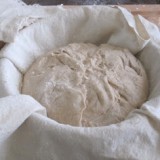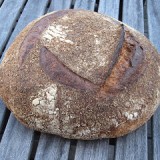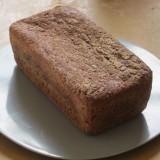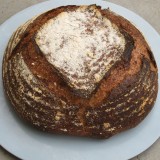
We get a fair amount of spam comments on this blog. Exterminators, search engine optimization purveyors and even, this morning someone promoting gossip news about Beyoncé and Jay-Z (a bit off topic for an appropriate technology blog, perhaps?).
One spam comment that came in last week fascinated me. The website had an extensive collection of bread baking how-to videos. Within a few minutes, on the first video I watched, the instructor was already selling a ton of equipment I’ve never heard of: strange $800 mixers, bread machines, dough conditioners etc. Even with the aid of all those gadgets and industrial ingredients, the instructor went on to describe a method of bread baking that involves a whole lot of unnecessary work to produce loaves that looked to me like squishy supermarket bread.
The ingredients you need to make bread are elemental in their simplicity: water, flour and salt and you can make a perfectly good loaf of bread with no equipment at all. But there are a few inexpensive pieces of equipment I like to use:
1. A digital Scale

Measuring flour and water by volume is so inaccurate that both of the professional bakers I took classes with last year refuse to give cup equivalents in their recipes. Using a digital scale solved 90% of my bread baking problems. The scale pictured above is not the scale that I own, unfortunately. The one I have works just fine, but the OXO Good Grips Scale has a really great feature: a pull out display. This makes it easier to read the scale when you’ve got a big bowl on top of it. It’s inexpensive, and I’ve seen it for sale at my local Whole Foods. It’s also the scale we use when I teach classes at the Institute of Domestic Technology.
2. A proofing basket

If you want to make a boule, you need a proofing basket. The one on the right is the economy option: a nine inch bowl from the 99¢ store with a piece of canvas or linen from a fabric store. The one on the left is a 8-inch Round Banneton Basket on Amazon. It works just as well as the much more expensive German bannetons I picked up at a restaurant supply store.
3. A loaf tin

On Josey Baker’s recommendation I’ve been using a loaf pan a lot lately. It’s a lot less trouble and a lot more forgiving than trying to shape a boule. Plus you get a good sandwich loaf. The loaf pan I’ve been using is a enamelware hand-me-down that measures 8 1/2 inches by 4 1/2 inches. Baker recommends one made by Chicago Metallic. I don’t like Teflon and you don’t need a non-stick pan. Use some oil and flour and your loaf shouldn’t stick.
4. A Dutch oven or combo cooker

Mark Bittman popularized the practice of baking boules in a Dutch oven. The technique simulates the humid environment of a commercial bread oven. It works great. For years I used a regular Dutch oven. Just recently, however, I purchased a Lodge Combo cooker, essentially a Dutch oven with a skillet instead of a lid. To bake bread in it you use it upside down. It’s easier to slide a loaf of bread into the pan than it is to plop a loaf down into a Dutch oven.
These few items, plus a plastic container large enough to ferment your dough in, are all you need. If you get fanatical about baking like I have you may want to consider a mill, but that will have to be the subject of a longer post. That said, I could make a decent, rustic looking loaf with absolutely no equipment at all (except, maybe, the scale). Bread is the most elemental of foods. It can be made with just our two hands.




Well, you also need a heat source… The people I’ve met here in Uruguay obsessed with making their own bread always emphasize having a “horno a leña para pan y pizza” (timber/wood oven for bread and pizza) over any technique or ingredient. This goes so far that real estate agents that know that for a certain kind of people, having one of these ovens sells a house much better than a swimming pool.
Good point! I left out the oven! And thanks for sharing–I always love hearing an international perspective. What kind of materials do people in Uruguay use? Bricks or earth? We built an earth oven in our backyard and it’s really great for pizza parties.
One benefit of preparing bread simply is how little clean up is necessary at each stage. Plus my equipment is all useful in other ways so no one-trick-gizmos clogging my cupboards. I do grind fresh whole-wheat flour in the VitaMix, which is a worthwhile step to me. I use two leCreuset Dutch ovens for Jim Lahey’s bread indoors (why make only one loaf?) and a Lodge cast iron Dutch oven for the same bread baked in the Big Green Egg. Life is good! Best wishes.
Amen to the junk not cluttering the kitchen. Our kitchen is already clogged with too much stuff. And good to hear about the VitaMix as a grain grinder. I’ve heard about doing that but have no first hand experience.
I agree, and I would add a stoneware slab or pizza stone. It evens out the heat fluctuations if your oven is temperamental or has uneven heat distribution. We almost gave up on bread making until we were given one.
I will have to try the dutch oven thing, I guess if makes a nice symmetrical loaf.
I have a pizza stone too. It’s really useful (though, in my case, painfully expensive). And the Dutch oven trick works great–it helps give the loaf more oven spring (the steam from the dough in the pot allows the bread to rise more than it would in a dry home oven–commercial bread ovens have a steam injection system).
Very good post.
O.K. now to the nuts-and-bolts questions: I have a starter that more than doubles, usually triples, in volume when I feed it. I understand that this is good. I weigh my ingredients carefully, follow the proofing and shaping directions slavishly, bake in a well pre-heated oven . . . so why could my sourdough bread be so disappointingly heavy? I live in a rural and not particularly bread-enlightened area, so there’s no one I can watch in order to figure out what I’m doing wrong. This is my great challenge; I can bake anything else and it turns out fabulously, but not natural yeast bread. Sigh.
Any suggestions, you bread gurus?
First are you using white or whole wheat flour? Whole wheat sucks up a lot more water so that could be an issue. Secondly, you could be either over-proofing or under-proofing. Both with result in a dense loaf. How long is your proofing time? What recipe are you working with?
Not sure how to reply to a reply on your website, so I’ll reply to me.
Mr. Homegrown: I have tried a variety of recipes, including the extensive recipe/directions in Michael Pollan’s book, “Cooked”. I have tried recipes with nothing more than water, flour and starter and recipes with a host of additions: fat, sweetener, etc.
So far, I have been using a combination of whole grain (hard red wheat and sometimes rye) flour that I usually grind myself to a fine texture along with some King Arthur unbleached white flour. I did try once using only white flour to see if that was the issue, but I didn’t notice much difference.
The long/overnight proof is beautiful. However, when I shape the bread, it fails to get much rise for the second go round. Doesn’t seem to matter if I do a roundish loaf or a regular-looking loaf in a pan. I’ve tried using a loaf-shaped clay baker and it’s only a slight improvement. I can make gorgeous bread using the Almost-no-knead recipe from the Cook’s Illustrated recipe book, but that uses dry yeast, not a starter. In fact, I can make all kinds of knock-your-socks-off bread with regular yeast, but getting a decent result from starter is my new goal in life.
This is more related to your cooking tips post but I’m posting here because I don’t know if you go back and review comments from old posts. I’d love if you guys talked about (blog or podcast) about stock, how to make it, how to use it, etc. Kelly touched on it but it was more in passing, I have no idea what I would do with stock once I made it!
That’s a great idea. I’ll ask Kelly to do a post with a recipe.
I totally understand the idea of weighing instead of a volume measure. I am not trying to be contentious, but how did people make good bread before scales were common? Or, was it not such good bread, just something that seemed good because it filled their stomachs and they were not as particular as we are?
> how did people make good bread before scales were common?
This was a period before measuring cups or standardized recipes; I’d imagine you’d mix water into flour ’til it looked right, and that people ate a lot of indifferent bread unless they had a talented baker in the area.
I know how to make bread by hand but I have to admit I like my bread mixer. For some reason, dough sticks to my hands (I’ve had that problem since I was a child making bread with my mother). If I use my mixer, I can make really good whole wheat bread. If I knead dough by hand, I end up with a brick because I need so much flour so I can work the dough. Weighing the flour as you suggest would eliminate the extra flour I need to knead the dough but because of my quirky hands I wouldn’t be able to knead the dough 🙂
It makes me crazy when people talk about Bittman bread (yes, I saw you only said “popularized”). It was Steve Lahey of the Sullivan Street Bakery who came up with the method. Bittman merely wrote about Lahey’s success with the no-knead method and baking in a hot enclosed container. Why are people so willing to overlook him and his contribution???
Jim Lahey, not Steve. He also wrote a great book about preparing fresh pizza, and it changed how we make it now: on the Big Green Egg, of course. Best wishes.